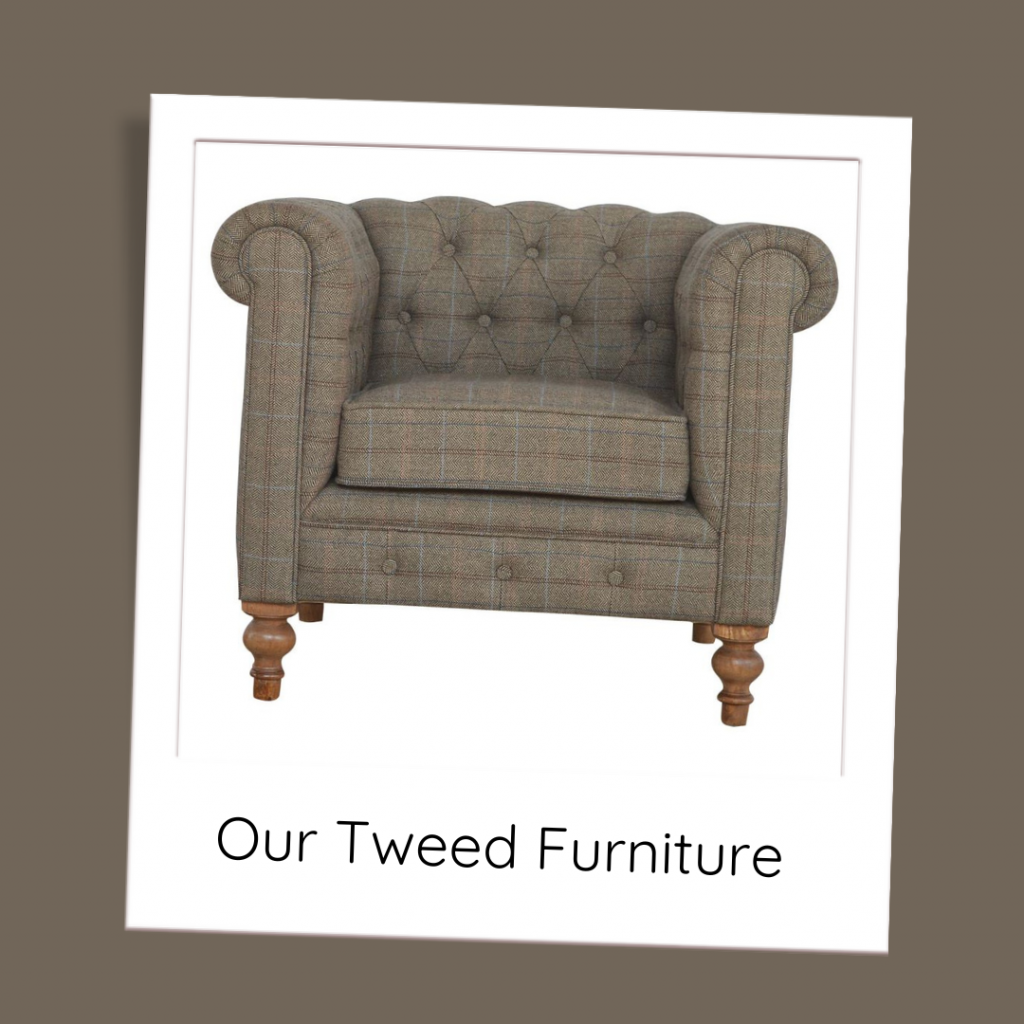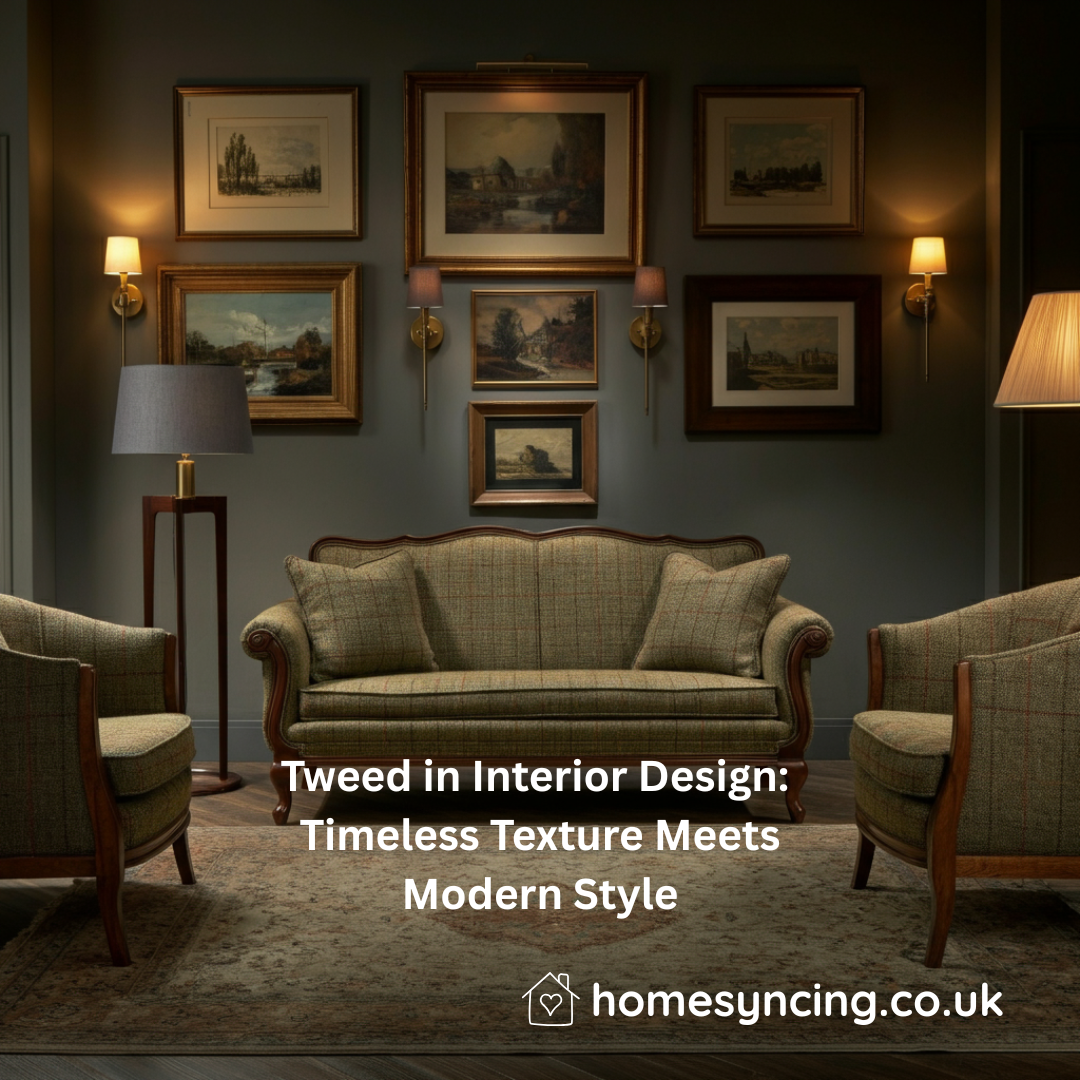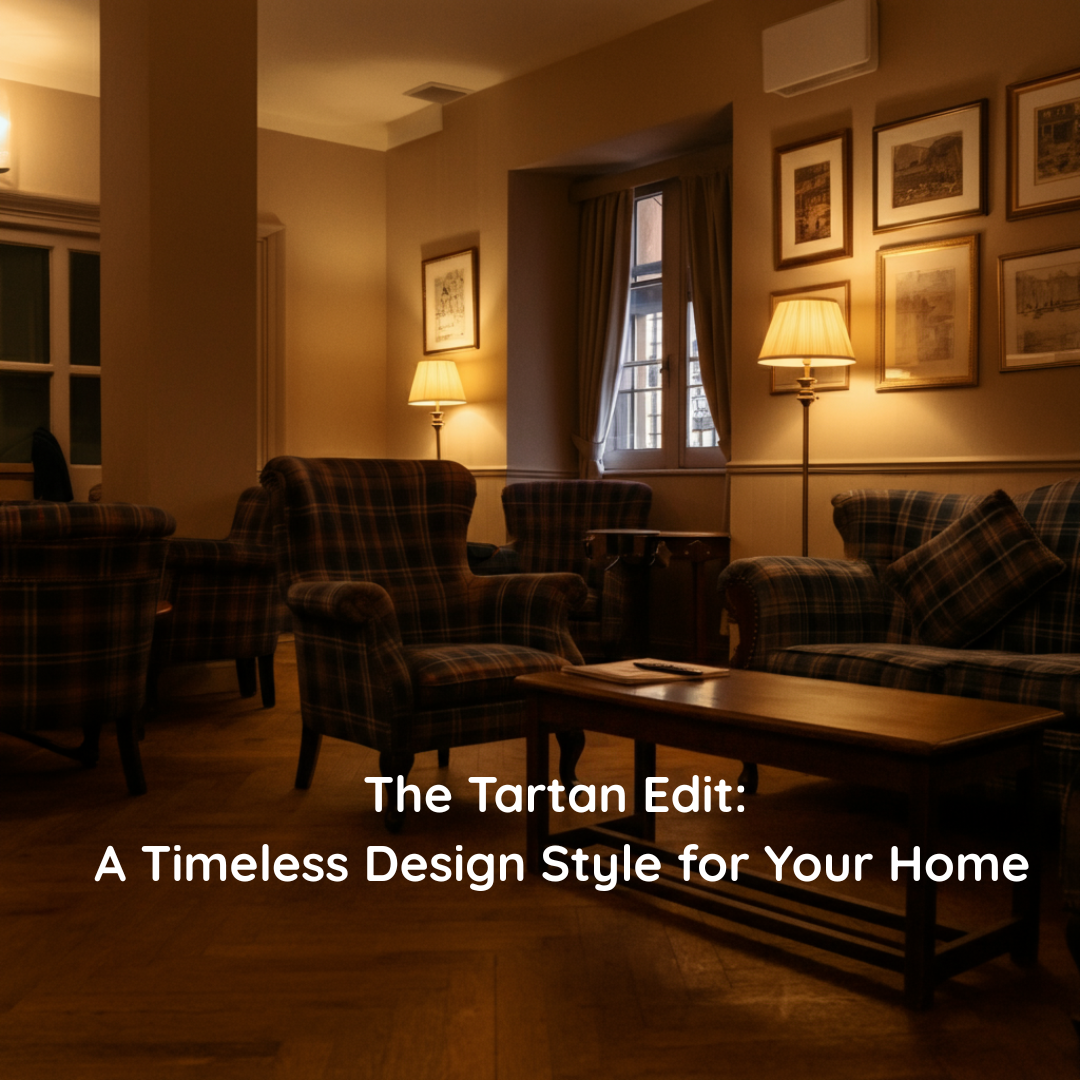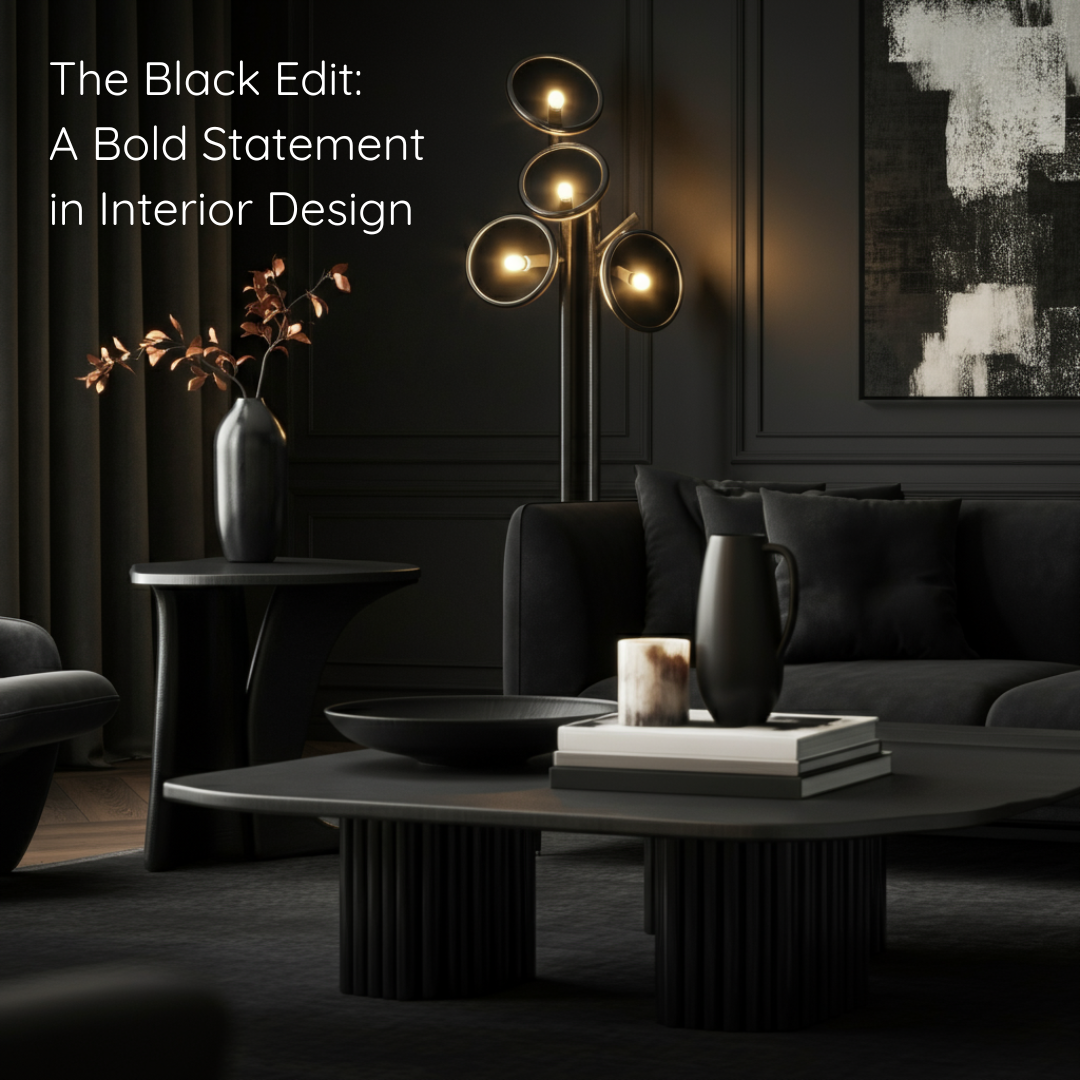When you think of tweed, perhaps images of countryside estates, tailored blazers or vintage hunting jackets come to mind. But this distinctive fabric has found a new life beyond the wardrobe. Tweed is making a powerful statement in interior design, bringing warmth, texture, and heritage into contemporary homes. Whether adorning an armchair, cushioning a sofa or adding character to wall panels, tweed offers a unique blend of rustic charm and refined elegance that few materials can match.
This guide explores the rich history of tweed, its defining characteristics, and how you can incorporate this classic textile into your home. From subtle accents to bold upholstery choices, tweed proves itself as versatile as it is enduring.
What is Tweed?
Tweed is a rough-textured woollen fabric, traditionally woven with a plain or twill weave and characterised by its soft, open texture. The fabric often features flecked patterns created by weaving together yarns of different colours, which gives tweed its signature depth and visual interest. Typically made from wool, tweed is known for its durability, warmth, and resistance to wind and water—qualities that made it indispensable in its country of origin.
The term “tweed” is believed to have originated from a misreading of the Scottish word “tweel” (the Scots word for twill). Another theory suggests the name derives from the River Tweed, which flows through the Scottish Borders where much of the fabric was historically produced. Regardless of its etymological roots, tweed has become synonymous with Scotland and the British Isles.
A Brief History of Tweed
Tweed’s story begins in the rural communities of Scotland and Ireland during the 18th and 19th centuries. Woven by hand on traditional looms, it was originally created as practical clothing for farmers, shepherds, and estate workers who needed protection from harsh weather. The fabric’s robust nature and insulating properties made it ideal for outdoor work.
By the Victorian era, tweed had transcended its utilitarian beginnings. Scottish landowners and the British aristocracy adopted it for country pursuits such as hunting, shooting, and fishing. Queen Victoria’s fondness for all things Scottish during her reign further elevated tweed’s status. Her purchase of Balmoral Castle in 1852 sparked a fashion for Highland dress and Scottish textiles, cementing tweed’s place in fashionable society.
Different regions developed their own distinctive tweeds. Harris Tweed, handwoven by islanders in the Outer Hebrides, became particularly renowned and is now protected by an Act of Parliament. Donegal tweed from Ireland features colourful flecks and slubs, while Cheviot tweed takes its name from the sheep breed native to the border hills between England and Scotland.
Throughout the 20th century, tweed remained a staple of country attire and academic dress. Fashion designers like Coco Chanel famously reimagined tweed for women’s wear in the 1920s, creating elegant suits that became iconic. More recently, tweed has experienced a renaissance in both fashion and interiors, appreciated for its texture, heritage, and sustainable qualities.
How to Use Tweed in Interior Design
Tweed brings a tactile richness to interiors that few other fabrics can replicate. Its textured surface catches light beautifully, creating depth and visual interest. The natural fibres lend warmth and authenticity, whilst the traditional patterns provide a connection to craft and history. Here’s how to harness tweed’s potential in your home.
Creating Atmosphere with Texture
Tweed excels at adding layers of texture to a room. Its woven surface introduces a tactile element that invites touch and creates visual complexity. When paired with smooth surfaces like polished wood, glass, or metal, tweed provides contrast that makes spaces feel more balanced and considered.
Consider the overall mood you wish to create. Tweed in earthy tones—browns, greys, mossy greens—evokes countryside retreats and cosy libraries. These colours work particularly well in studies, living rooms, and bedrooms where a sense of refuge is desired. Lighter tweeds in cream, oatmeal, or soft grey can brighten spaces whilst maintaining texture and warmth, making them suitable for both traditional and contemporary settings.
For those seeking drama, tweed in deeper hues such as charcoal, navy, or forest green can anchor a room and provide a sophisticated backdrop. These darker shades work especially well in larger pieces like sofas or curtains, where they create impact without overwhelming the space.
Balancing Traditional and Modern
One of tweed’s greatest strengths is its ability to bridge different design eras. In traditional interiors, tweed feels entirely at home alongside dark woods, leather, and brass fixtures. It reinforces the heritage aesthetic without appearing costume-like or contrived.
In modern and contemporary spaces, tweed introduces an unexpected element that adds warmth and prevents interiors from feeling stark or impersonal. A tweed-upholstered chair in a minimalist room becomes a statement piece, its texture and pattern providing focal interest. Similarly, tweed cushions on a sleek modern sofa can soften the lines whilst adding personality.
Mixing tweed with other natural materials creates harmony. Pair it with linen, leather, wood, stone, or wool for a cohesive look that celebrates natural textures. Avoid overwhelming a room with too many competing patterns—if you’re using a heavily flecked tweed, balance it with solid colours or subtle textures elsewhere.
Interior Design Ideas Using Tweed
Ready to introduce tweed into your home? Here are some inspiring ways to incorporate this classic fabric across different rooms and applications.
Upholstered Furniture
Tweed-covered furniture makes a lasting impression. A statement armchair upholstered in Harris Tweed becomes an heirloom piece, combining comfort with craftsmanship. The fabric’s durability means it can withstand daily use whilst developing character over time.
Sofas upholstered in tweed anchor living rooms beautifully. Choose a classic herringbone pattern in neutral tones for versatility, or select a more vibrant Donegal tweed if you want your sofa to become the room’s focal point. Tweed’s texture hides minor wear better than smooth fabrics, making it practical for family homes.
For a more subtle approach, consider an ottoman or footstool in tweed. These smaller pieces allow you to experiment with the fabric without committing to a large upholstery project. They’re also easier to reposition, letting you move colour and texture around your space as your mood or décor changes.
Soft Furnishings and Accessories
If reupholstering furniture feels too permanent, soft furnishings offer an accessible entry point. Tweed cushions scattered across a sofa or bed instantly add depth and interest. Mix different tweed patterns and colours for an eclectic, layered look, or stick to a single shade for understated elegance.
Throws and blankets in tweed provide both visual appeal and practical warmth. Draped over the arm of a chair or folded at the foot of a bed, they invite use whilst contributing to the room’s aesthetic. Tweed curtains or Roman blinds introduce pattern and texture to windows, softening hard architectural elements whilst providing privacy and insulation.
Even smaller accessories can make an impact. Tweed lampshades diffuse light beautifully, creating a warm glow. Covered storage boxes or book covers in tweed add coordinated texture to shelves and surfaces.
Wall Treatments and Panels
For those seeking something truly distinctive, tweed wall panels create a striking effect. Upholstered wall panels in a study or library add acoustic softening whilst enveloping the room in texture. The fabric’s natural insulation properties also provide subtle warmth.
Alternatively, use tweed as a headboard covering. Stretching tweed across a simple frame creates an upholstered headboard that adds softness and luxury to a bedroom. Choose a herringbone or check pattern for visual interest, or opt for a heathered solid if you prefer subtlety.
Tweed can even be framed as textile art. A beautiful piece of Harris Tweed or vintage Donegal tweed mounted in a simple frame becomes a sculptural wall hanging, celebrating the fabric’s pattern and weave.

Dining Spaces
Tweed brings unexpected warmth to dining areas. Chair seats upholstered in tweed transform ordinary dining chairs into characterful seating. The fabric’s durability makes it practical for this high-use application, whilst its texture adds visual richness.
For a more temporary update, consider tweed chair pads or seat cushions tied to chair backs. These can be changed seasonally or when you fancy a refresh. Table runners in tweed (or tweed-look fabrics) can also introduce texture to tablescapes, particularly effective for autumn and winter entertaining.
Tweed-Finished Furniture and Styling Your Home
Pre-finished tweed furniture offers convenience for those who want the look without undertaking upholstery projects. Many furniture makers and retailers now offer pieces featuring tweed or tweed-inspired fabrics, making it easier than ever to incorporate this textile into your home.
Choosing Ready-Made Tweed Pieces
When selecting tweed furniture, examine the quality of both the fabric and the construction. Authentic Harris Tweed bears a certification label guaranteeing it was handwoven in the Outer Hebrides from pure virgin wool. This marks a piece of genuine heritage and ensures durability.
For other tweeds, check the composition. Pure wool provides the best wearing qualities, though wool blends with a small percentage of synthetic fibres can offer easier care. Feel the fabric—it should be substantial without being stiff, with a pleasant texture against the hand.
Consider the furniture’s frame and construction as well. A beautifully upholstered chair deserves a sturdy foundation. Look for hardwood frames, proper springing, and quality foam or traditional stuffing. Well-made tweed furniture should last for decades, developing a pleasing patina rather than showing shabby wear.
Styling Tweed in Your Home
Once you’ve acquired tweed pieces, thoughtful styling brings out their best qualities. In a living room, position a tweed armchair near a window where natural light can highlight the fabric’s texture and colour variations. Pair it with a reading lamp and a small side table to create an inviting reading nook.
Layer your tweed furniture with complementary textiles. A sheepskin throw draped over a tweed chair adds luxury and warmth. Velvet or linen cushions provide textural contrast whilst picking up colours from the tweed’s flecked pattern.
Surrounding materials matter too. Tweed looks particularly handsome against exposed wood—whether polished floorboards, rustic ceiling beams, or wooden furniture. The natural affinity between wood and wool creates harmonious compositions. Stone and brick also complement tweed beautifully, reinforcing the fabric’s connection to natural materials and rural landscapes.
Don’t shy away from mixing tweed with more refined elements. A tweed chair can hold its own in a room featuring crystal chandeliers, gilt mirrors, or silk curtains. This juxtaposition of rustic and refined creates depth and prevents interiors from feeling one-dimensional.
Caring for Tweed
Proper care ensures your tweed furnishings remain beautiful for years. Regular vacuuming with an upholstery attachment prevents dust from settling into the weave. For spills, blot immediately with a clean, absorbent cloth—avoid rubbing, which can damage the fibres or spread the stain.
Most tweeds are dry-clean only, so consult a professional for deep cleaning or stain removal. Between cleanings, refresh upholstered pieces by taking cushions outdoors on a dry day and giving them a gentle beating to release dust. The fresh air will also help dissipate any lingering odours.
Rotate cushions regularly to ensure even wear. If your tweed piece receives direct sunlight, consider using window treatments to prevent fading. Though tweed is remarkably durable, these simple practices will extend its life and maintain its appearance.
Embracing Heritage in Modern Homes
Tweed’s journey from Highland hillsides to contemporary interiors reflects our enduring appreciation for materials that combine beauty with purpose. Its texture tells stories of craft traditions, rural landscapes, and the skilled hands that worked the looms. When you choose tweed for your home, you’re not simply selecting a fabric—you’re bringing in a piece of cultural heritage that adds depth and meaning to your surroundings.
Whether you opt for a single statement chair or layer tweed throughout your rooms, this distinctive textile rewards those willing to embrace its character. Its natural warmth, visual interest, and remarkable durability make it a wise choice for homes that value substance alongside style.
As you consider your next interior update, look beyond fleeting trends to materials with proven longevity. Tweed has weathered centuries of changing fashions because it offers something timeless: honest beauty rooted in craft and landscape. Your home deserves furnishings that will grow more beloved with age. Tweed delivers exactly that.
Further Reading: Affordable Decorating Ideas That Will Transform Your Home
Daily Inspiration: Follow Us on Instagram, BlueSky, Threads , Pinterest, Twitter, TikTok






